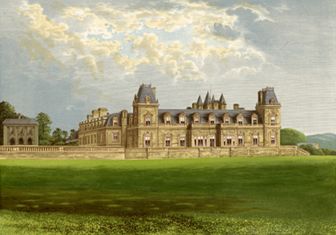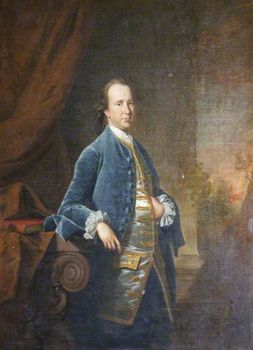|
Shapwick, Somerset
Shapwick is a village on the Polden Hills overlooking the Somerset Moors, in the Sedgemoor district of Somerset, England. It is situated to the west of Glastonbury. History Shapwick is the site of one end of the Sweet Track, an ancient causeway dating from the 39th century BC. In 1998 a hoard of 9,238 silver denarii (the second largest hoard ever found from the Roman Empire, and the largest in the United Kingdom) was discovered in the remains of a previously unknown Roman villa near Shapwick. Following a Treasure Inquest in Taunton, the hoard was valued and acquired in its entirety by Somerset County Museums Service for the sum of £265,000. It became known as the Shapwick Hoard. The parish of Shapwick was part of the Whitley Hundred. Due to the plan of its roads and streets academics have described it as a "typical English village". Shapwick is one of the nine Thankful Villages in Somerset — those that suffered no casualties in World War I. Manor The manor of ... [...More Info...] [...Related Items...] OR: [Wikipedia] [Google] [Baidu] |
Church Of The Blessed Virgin Mary, Shapwick
The Church of the Blessed Virgin Mary in Shapwick within the English county of Somerset was consecrated in 1331. It is a Grade II* listed building. History The building was constructed in the early 14th century and consecrated in 1331. It replaced an earlier building which existed in 1168 but may go back to a charter of 971. The new building had the same dimensions as the previous church. The church was under the patronage of Glastonbury Abbey.'Shapwick', in A History of the County of Somerset: Volume 8, the Poldens and the Levels, ed. Robert Dunning (London, 2004), pp. 160-179. British History Online http://www.british-history.ac.uk/vch/som/vol8/pp160-179 ccessed 30 April 2017 Its central two-stage tower is a style that was at least a century out of date when it was built in the 15th century as part of wider alterations to the church. Further restoration was undertaken in 1861 by George Gilbert Scott. The parish is part of the Polden Wheel benefice within the Diocese of Bat ... [...More Info...] [...Related Items...] OR: [Wikipedia] [Google] [Baidu] |
Whitley (hundred)
The Hundred of Whitley is one of the 40 historical Hundreds in the ceremonial county of Somerset, England, dating from before the Norman conquest during the Anglo-Saxon era although exact dates are unknown. Each hundred had a 'fyrd', which acted as the local defence force and a court which was responsible for the maintenance of the frankpledge system. They also formed a unit for the collection of taxes. The role of the hundred court was described in the Dooms (laws) of King Edgar. The name of the hundred was normally that of its meeting-place. It got its name from Whitley wood in Walton. Two previous units Loxley and Ringoldsway were merged to form Whitley Hundred in the 12th century. The Hundred of Whitley consisted of the ancient parishes of: Ashcott, Blackford, Butleigh, Compton Dundon, Cossington, Greinton, High Ham, Holford, Holton, Middlezoy, West Monkton, Moorlinch, Othery, Milton Podimore, Shapwick, Street, Walton, Westonzoyland, Wheathill, and Woolavingto ... [...More Info...] [...Related Items...] OR: [Wikipedia] [Google] [Baidu] |
Lindridge
Lindridge is a village and civil parish in the Malvern Hills District in the north of the county of Worcestershire, England, near the Shropshire border and the town of Tenbury Wells Tenbury Wells (locally Tenbury) is a market town and civil parish in the northwestern extremity of the Malvern Hills District of Worcestershire, England. Its northern border adjoins Shropshire, and at the 2011 census it had a population of 3,777. .... The area around the village is known for its extensive hop fields. External links * Villages in Worcestershire Civil parishes in Worcestershire {{Worcestershire-geo-stub ... [...More Info...] [...Related Items...] OR: [Wikipedia] [Google] [Baidu] |
East India Company
The East India Company (EIC) was an English, and later British, joint-stock company founded in 1600 and dissolved in 1874. It was formed to trade in the Indian Ocean region, initially with the East Indies (the Indian subcontinent and Southeast Asia), and later with East Asia. The company seized control of large parts of the Indian subcontinent, colonised parts of Southeast Asia and Hong Kong. At its peak, the company was the largest corporation in the world. The EIC had its own armed forces in the form of the company's three Presidency armies, totalling about 260,000 soldiers, twice the size of the British army at the time. The operations of the company had a profound effect on the global balance of trade, almost single-handedly reversing the trend of eastward drain of Western bullion, seen since Roman times. Originally chartered as the "Governor and Company of Merchants of London Trading into the East-Indies", the company rose to account for half of the world's trad ... [...More Info...] [...Related Items...] OR: [Wikipedia] [Google] [Baidu] |
Stevenstone
Stevenstone is a former manor within the parish of St Giles in the Wood, near Great Torrington, North Devon. It was the chief seat of the Rolle family, one of the most influential and wealthy of Devon families, from c. 1524 until 1907. The Rolle estates as disclosed by the Return of Owners of Land, 1873 (corrected by Bateman, 1883) comprised 55,592 acres producing an annual gross income of £47,170, and formed the largest estate in Devon, followed by the Duke of Bedford's estate centred on Tavistock comprising 22,607 with an annual gross value of nearly £46,000. From the Glorious Revolution of 1688 to the Reform Act of 1832 the county parliamentary representatives were chosen effectively from only ten great families, mostly territorial magnates. The three most dominant of these were the Bampfyldes of Poltimore House and North Molton, the Courtenays of Powderham Castle, and the Rolles of Stevenstone and Bicton. The Rolles were not from the mediaeval aristocracy as were ... [...More Info...] [...Related Items...] OR: [Wikipedia] [Google] [Baidu] |
Denys Rolle (died 1797)
Denys Rolle (1725 – 1797) of Hudscott, Beam, Stevenstone and Bicton in Devon and East Tytherley in Hampshire, was an independent Member of Parliament for Barnstaple, Devon, between 1761 and 1774. He inherited a large number of estates and by the time of his death he was the largest landowner in Devon. He was a philanthropist and generous benefactor to charities and religious societies. He spent much of his life in Florida attempting to establish an "ideal society", a Utopian colony of poor, homeless or criminal English persons named Rollestown or Charlotta. The project was a failure and Rolle recorded his colonial adventure in great detail in a lengthy official complaint made in 1765 to the British government entitled ''The Humble Petition of Denys Rolle, Esq., Setting Forth the Hardships, Inconveniences, and Grievances Which Have Attended Him in His Attempts to Make a Settlement in East Florida, Humbly Praying Such Relief as in their Lordships Wisdom Shall Seem Meet''. His ... [...More Info...] [...Related Items...] OR: [Wikipedia] [Google] [Baidu] |
Henry Rolle
Sir Henry Rolle (1589–1656), of Shapwick in Somerset, was Chief Justice of the King's Bench and served as MP for Callington, Cornwall, (1614–1623–4) and for Truro, Cornwall (1625–1629). Origins Henry Rolle was born ''circa'' 1589, the second son of Robert Rolle (d. 1633) of Heanton Satchville in the parish of Petrockstowe, Devon, by his wife Joan Hele, daughter of Thomas Hele of Fleet, Devon. Henry was a great-grandson, in a junior line, of George Rolle (c.1486-1552) of Stevenstone, Devon, founder of the influential and wealthy Rolle family of Devon, Keeper of the Records of the Court of Common Pleas and MP for Barnstaple in 1542 and 1545. His brothers included: *Sir Samuel I Rolle (c.1588-1647) (eldest brother) of Heanton Satchville, Member of Parliament for Callington, Cornwall in 1640 and for Devon 1641-1647 and a supporter of the parliamentary side in the Civil War. * John Rolle (1598–1648) (younger brother) a Turkey Merchant and MP for Callington, Corn ... [...More Info...] [...Related Items...] OR: [Wikipedia] [Google] [Baidu] |
Shapwick House (geograph 5329174)
Shapwick may refer to: * Shapwick, Dorset, England * Shapwick, Somerset, England * The Shapwick Hoard The Shapwick Hoard is a hoard of 9,262 Roman coins found at Shapwick, Somerset, England in September 1998. The coins dated from as early as 31–30 BC up until 224 AD. The hoard also notably contained two rare coins which had not been discovere ..., a Roman coin discovery in Shapwick, Somerset {{place name disambiguation ... [...More Info...] [...Related Items...] OR: [Wikipedia] [Google] [Baidu] |
Glastonbury Abbey
Glastonbury Abbey was a monastery in Glastonbury, Somerset, England. Its ruins, a grade I listed building and scheduled ancient monument, are open as a visitor attraction. The abbey was founded in the 8th century and enlarged in the 10th. It was destroyed by a major fire in 1184, but subsequently rebuilt and by the 14th century was one of the richest and most powerful monasteries in England. The abbey controlled large tracts of the surrounding land and was instrumental in major drainage projects on the Somerset Levels. The abbey was suppressed during the Dissolution of the Monasteries under King Henry VIII of England. The last abbot, Richard Whiting (Whyting), was hanged, drawn and quartered as a traitor on Glastonbury Tor in 1539. From at least the 12th century the Glastonbury area has been associated with the legend of King Arthur, a connection promoted by medieval monks who asserted that Glastonbury was Avalon. Christian legends have claimed that the abbey was founded b ... [...More Info...] [...Related Items...] OR: [Wikipedia] [Google] [Baidu] |
Manorialism
Manorialism, also known as the manor system or manorial system, was the method of land ownership (or " tenure") in parts of Europe, notably France and later England, during the Middle Ages. Its defining features included a large, sometimes fortified manor house in which the lord of the manor and his dependents lived and administered a rural estate, and a population of labourers who worked the surrounding land to support themselves and the lord. These labourers fulfilled their obligations with labour time or in-kind produce at first, and later by cash payment as commercial activity increased. Manorialism is sometimes included as part of the feudal system. Manorialism originated in the Roman villa system of the Late Roman Empire, and was widely practiced in medieval western Europe and parts of central Europe. An essential element of feudal society, manorialism was slowly replaced by the advent of a money-based market economy and new forms of agrarian contract. In examining ... [...More Info...] [...Related Items...] OR: [Wikipedia] [Google] [Baidu] |






